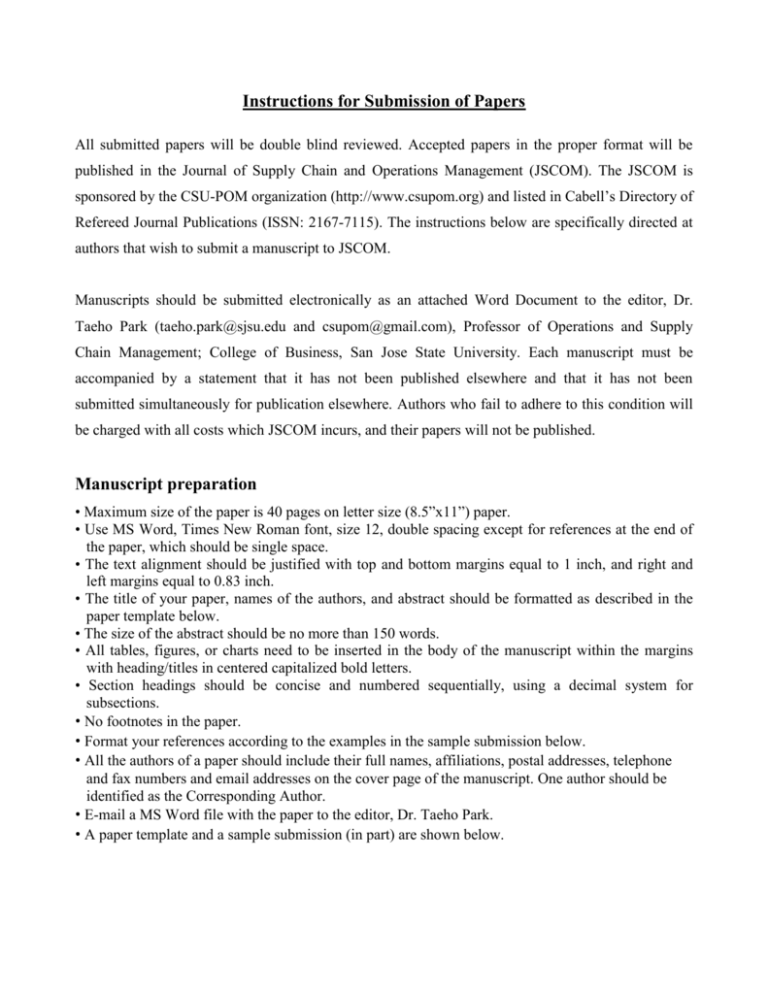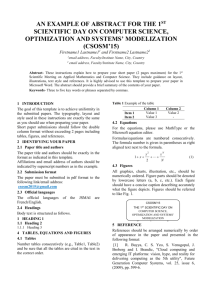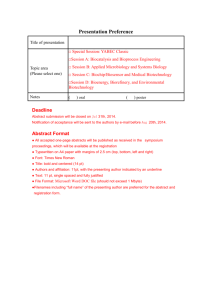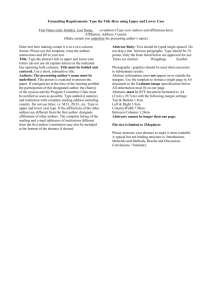Manuscript. - csu
advertisement

Instructions for Submission of Papers All submitted papers will be double blind reviewed. Accepted papers in the proper format will be published in the Journal of Supply Chain and Operations Management (JSCOM). The JSCOM is sponsored by the CSU-POM organization (http://www.csupom.org) and listed in Cabell’s Directory of Refereed Journal Publications (ISSN: 2167-7115). The instructions below are specifically directed at authors that wish to submit a manuscript to JSCOM. Manuscripts should be submitted electronically as an attached Word Document to the editor, Dr. Taeho Park (taeho.park@sjsu.edu and csupom@gmail.com), Professor of Operations and Supply Chain Management; College of Business, San Jose State University. Each manuscript must be accompanied by a statement that it has not been published elsewhere and that it has not been submitted simultaneously for publication elsewhere. Authors who fail to adhere to this condition will be charged with all costs which JSCOM incurs, and their papers will not be published. Manuscript preparation • Maximum size of the paper is 40 pages on letter size (8.5”x11”) paper. • Use MS Word, Times New Roman font, size 12, double spacing except for references at the end of the paper, which should be single space. • The text alignment should be justified with top and bottom margins equal to 1 inch, and right and left margins equal to 0.83 inch. • The title of your paper, names of the authors, and abstract should be formatted as described in the paper template below. • The size of the abstract should be no more than 150 words. • All tables, figures, or charts need to be inserted in the body of the manuscript within the margins with heading/titles in centered capitalized bold letters. • Section headings should be concise and numbered sequentially, using a decimal system for subsections. • No footnotes in the paper. • Format your references according to the examples in the sample submission below. • All the authors of a paper should include their full names, affiliations, postal addresses, telephone and fax numbers and email addresses on the cover page of the manuscript. One author should be identified as the Corresponding Author. • E-mail a MS Word file with the paper to the editor, Dr. Taeho Park. • A paper template and a sample submission (in part) are shown below. Paper Title Subtitle as needed Authors Name/s per 1st Affiliation, e-mail address name of organization, City, State, Country Authors Name/s per 2nd Affiliation, e-mail address name of organization, City, State, Country (Continue on for the other authors, if any more) * Corresponding Author. E-mail address: e-mail@address.edu ABSTRACT This electronic document is a “live” template. The size of the abstract should be no more than 150 words. The line space should be double spacing. I. INTRODUCTION (Heading 1 should be bold) This template, modified in MS Word 2003 and saved as “Word 97-2003” for the PC, provides authors with most of the formatting specifications needed for preparing electronic versions of their papers. Margins, column widths, line spacing, and type styles are built-in; examples of the type styles are provided throughout this document. Before you begin to format your paper, first write and save the content as a separate text file. II. USE OF THIS TEMPLATE 2.1. Selecting a Template (Heading 2) You should have a correct template for your paper size. This template has been tailored for output on the US-letter paper size. If you are using A4 size, please change it to letter size. The template is used to format your paper and style the text. 2.2. Maintaining the Integrity of the Specifications All margins, column widths, line spaces, and text fonts are prescribed; please do not alter them. Insert page number at the bottom of pages. 2.3. Authors and Affiliations The template is designed so that author affiliations are not repeated each time for multiple authors of the same affiliation. Please keep your affiliations as succinct as possible. This template was designed for two affiliations. 1) For author/s of only one affiliation (Heading 3): To change the default, adjust the template as follows. a) Selection (Heading 4): Highlight all author lines. b) For author/s of more than two affiliations: To change the default, adjust the template. 2.4. Figures and Tables Positioning Figures and Tables: Large figures and tables may span across pages. Figure captions should be below the figures; table heads should appear above the tables. Insert figures and tables after they are cited in the text. Use the abbreviation “Fig. 1”, even at the beginning of a sentence. TABLE 1. TABLE TYPE STYLES. Table Head copy Table Column Head Table column subhead Subhead More table copy Subhead FIGURE 1. U.S. UNEMPLOYMENT RATE. III. EQUATIONS The equations are an exception to the prescribed specifications of this template. You will need to determine whether or not your equation should be typed using either the Times New Roman or the Symbol font (please no other font). To create multileveled equations, it may be necessary to treat the equation as a graphic and insert it into the text after your paper is styled. Number equations consecutively. Equation numbers, within parentheses, are to position flush right, as in (1), using a right tab stop. Punctuate equations with commas or periods when they are part of a sentence, as in Be sure that the symbols in your equation have been defined before or immediately following the equation. Use “(1)”, not “Eq. (1)” or “equation (1)”, except at the beginning of a sentence: “Equation (1) is . . .” Acknowledgment (HEADING 5) The preferred spelling of the word “acknowledgment” in America is without an “e” after the “g”. Avoid the stilted expression, “One of us (R. B. G.) thanks . . .” Instead, try “R. B. G. thanks”. IV. REFERENCES Listing sources of information at the end of a paper is an important part of professional scholarship and writing. It is highly suggested that all references should be check if they are complete: no missing or uncited references. The references should be listed in the alphabetic order of the last name of the first author. Refer to the author’s last name and published year in the parenthesis, as in (Cox and King, 2006) except at the beginning of a sentence: “Cox and King (2006) demonstrated . . .” Unless there are six authors or more give all authors' names; do not use “et al.”. Papers that have not been published, even if they have been submitted for publication, should be cited as “unpublished”. Papers that have been accepted for publication should be cited as “in press”. Capitalize only the first word in a paper title, except for proper nouns and element symbols. For papers published in translation journals, please give the English citation first, followed by the original foreign-language citation. Please refer to the following examples of citation formats for journals, conferences, books, electronic media, and magazine & newspaper articles. 1) Journal Articles Foster, S.T., “Towards an Understanding of Supply Chain Quality Management”, Journal of Operations Management, 26(4), 2008, 461–467. Lee, E.J. and Park, J.K., “Service Failures in Online Double Deviation Scenarios: Justice Theory Approach”, Managing Service Quality, 20(1), 2010, 46-69. Kelley, S.W., Hoffman, D. and Davis, M.A., “A Typology of Retail Failures and Recoveries”, Journal of Retailing, 69(4), 1993, 429-452. 2) Conferences Articles Bourassa, S., ‘Effects of child care on young children’, Proceedings of the third annual meeting of the International Society for Child Psychology, International Society for Child Psychology, Atlanta, Georgia, 1999, 44-46. Adelman, R., “‘Such Stuff as Dreams Are Made On’: God’s Footstool in the Aramaic Targumim and Midrashic Tradition,” Presented at the annual meeting for the Society of Biblical Literature, New Orleans, Louisiana, November 21–24, 2009. 3) Books Foster Jr., S.T., Managing Quality: Integrating the Supply Chain, Prentice-Hall, Upper Saddle River, NJ, 2007. Winston, W. and Albright, S.C., Practical Management Science (2nd ed.), Brooks/Cole, Pacific Grove, CA, 2001. Jones, P.J., Smith, R. and Watson, E.P. (eds), Artificial Intelligence Reconsidered (2nd ed.), Wiley, New York, 1988. Aronoff, G.R., Berns, J.S., Brier, M.E., et al., Drug Prescribing in Renal Failure (4th ed.), American College of Physicians, Philadelphia, PA, 1999. Guyton J.L. and Crockarell, J.R., Fractures of Acetabulum and Pelvis, In Canale, S.T. (ed.), Campbell's Operative Orthopaedics (10th ed.), Mosby, Inc., Philadelphia, PA, 2003, 2939-2984. 4) Electronic Media Devitt, T., “Lightning injures four at music festival,” The Why? Files, August 2, 2001, http://whyfiles.org/137lightning/index.html (accessed January 23, 2002). Dove, R., “Lady Freedom among Us,” The Electronic Text Center, 1998, http://etext.lib.virginia.edu/subjects/afam.html (accessed June 19, 1998). University of Georgia, "Points of Pride," University of Georgia, http://www.uga.edu/profile/pride.html (accessed October 21, 2009). Kachru, B.B., “Norms, models and identities," The Language Teacher Online, 20(10), 1996, http://jaltpublications.org/tlt/files/96/oct/index.html (accessed October 25, 2001). 5) Magazine & Newspaper Articles Henry, W.A., III., “Making the grade in today's schools,” Time, April 9, 1990, 28-31. Kalette, D., “California town counts town to big quake,” USA Today, July 21, 1986, A1.






